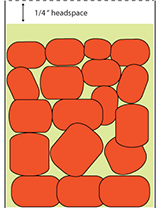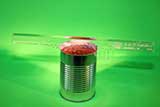Meats and Sausages
Headspace
The unfilled space above the food in a sealed container and below its lid is termed headspace. The amount of headspace required depends on the type of food being canned. For example, starchy foods tend to expand when heated and therefore require more headspace. Headspace is of lesser importance in metal cans because the cans withstand the inside pressure quite well and allow the food to expand without spreading the seams. It is, however, accepted trade practice to reserve about 6% of the volume of the can for headspace. The meats packed in cans in home production are usually filled with hot broth or hot water leaving about 1/4 inch headspace. Heating air is a slow process so any additional volume of air will adversely affect the heat transfer.
Leaving the specified amount of headspace in a jar is important to assure a vacuum seal. If too little headspace is present the food may expand and bubble out when air is being forced out from under the lid during processing. The bubbling food, especially fat, may leave a deposit on the rim of the jar or the seal of the lid and prevent the jar from sealing properly. If too much headspace is present, the food at the top is likely to discolor. Also, the jar may not seal properly because there will not be enough processing time to drive all the air out of the jar. And more air means more oxygen available to discolor the food and promote rancidity in fats.
Headspace is needed for the expansion of food as jars are processed and for forming vacuums upon cooling. The extent of the expansion is determined by the air content in the food and by the processing temperature. Air expands greatly when heated to high temperatures; the higher the temperature the greater the expansion. Foods expand less than air when heated.
The headspace for most products processed in cans at 240-250° F, 116-121° C, should be no less than 6% and no more than 10%. The proper amount of headspace contributes to the formation of a vacuum inside a can and is needed to accommodate the expanding food and gasses.
Headspace in Glass Jars:
Jams and jellies - 1/4 inch
Fruits and tomatoes - 1/2 inch
Meats, poultry, fish - 1 - 1-1/4 inch
Headspace in Metal Cans:
Meats, poultry, fish - No. 2 can (307 x 409) - 1/2 inch
No. 3 can (404 x 414) - 3/4 inch
When the clear plastic teeth of the headspace gauge contact the liquid level in a container, the diffused light indicates the headspace to 1/16 inch.



















